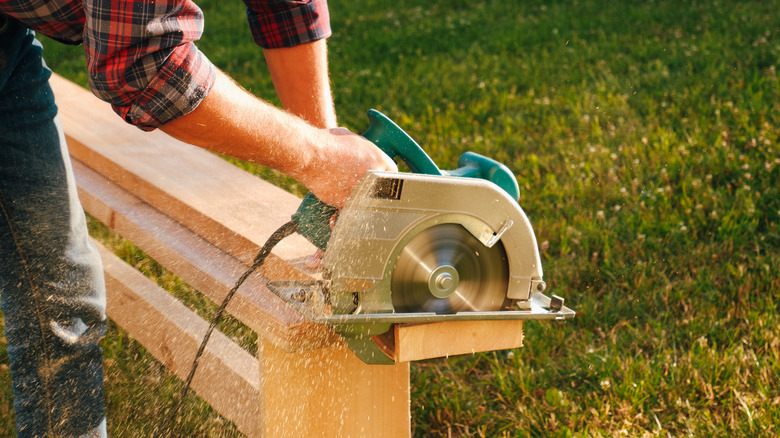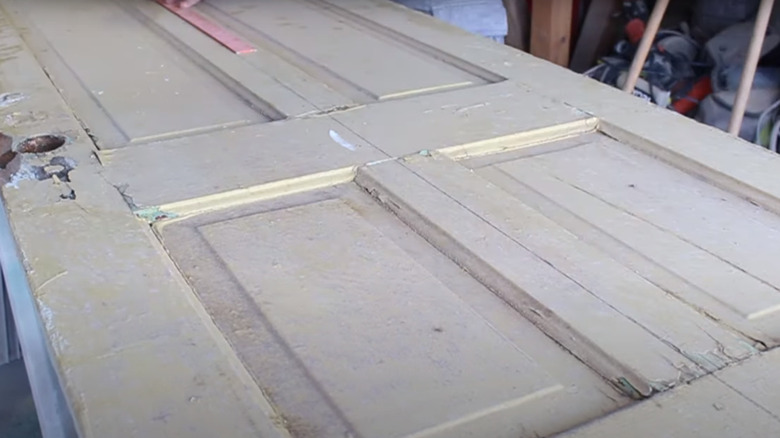Use This Stunning DIY To Repurpose An Old Door Into A Charming Front Porch Swing
Whether you're sinking into your latest book or just kicking back with your musings, a front porch swing is the ultimate chill spot. There's something extra special about those peaceful sessions amidst the back-and-forth sways. However, you do not need to splurge on a fancy swing from the store. Have you got an old door just collecting dust somewhere? If so, you can repurpose it into an adorable yet functional DIY porch swing with a bit of elbow grease and a handful of supplies.
You can always buy a porch swing, of course, but that might not be the thriftiest option. For example the Amish Casual Malvern Porch Swing on Wayfair goes for $959.99. And if you're eyeing something fancier, you're looking at over a grand. Meanwhile, a DIY swing serves the same function at a fraction of the cost. Keeping your bank account happy aside, you're also doing Mother Nature a small favor by giving that old door a new lease of life and keeping it out of a landfill.
How an old door becomes a porch swing
The endeavor to repurpose an old door into a porch swing bed kicks off with rounding up the essentials, including an old door, 2x4s and 1x6 planks of wood, a drill driver, eye bolts, paint, and a chain. First up, brainstorm about how roomy you want your swing and translate that vision into measurements on 2x4s. Next, slice your marked 2x4s to size, then glue and screw or nail them into a rectangular base reinforced with 2x4 support pieces.
Now, tailor your 1x6 planks to stretch across the frame's length and secure them on top. Flip the seat over and secure two 2x4s lengthwise, leaving 4 inches hanging off each side. After that, align your old door vertically against the frame back and fasten it securely. If a straight-back seat sounds too rigid for your taste, slicing the back length of the seat frame at a slight angle will give your backrest a laid-back tilt. Now, for the armrests, whip them up out of some old timber and secure them in place.
Approaching the finish line, sand your creation down and possibly slap on some latex paint for that fresh-out-of-the-workshop look. Next, drill holes on the sticking-out 2x4s, attach the eye bolts, and thread through your sturdy chains or ropes. You can now hang your DIY porch swing from your porch ceiling. For the cherry on top, pile on a bunch of plump cushions and throw pillows.
Extra considerations for a DIY porch swing
Got another extra door lying around? If so, perfect — you can use it for the seat instead of building the lower portion of your new porch swing yourself. Just be sure the repurposed door can handle the maximum load of the occupants. Plus, why shell out bucks for cushions when you could repurpose an old mattress into a plush add-on for your DIY porch swing bed? Metal brackets and corner braces could beef up your porch swing to make sure it stands the test of time (and weight).
If the idea of hunting down extra 2x4s for the overhangs sounds like more hassle than it's worth, the eye bolts will do just as fine when screwed to the sides of the seat frame. And in terms of materials, steel might have some advantages over wood for the seat frame. Just throw on a coat of rust-inhibiting primer like the Rust-Oleum protective enamel paint on Amazon to keep it looking sharp and thwart rust.
For a clever fix for your armrests, why not use spare chair legs to fill the gaps, much like you reinforced the seat frame? It's practical, adds a quirky charm, and ties the whole thing together. Once your masterpiece is swinging in the breeze, don't kick back and forget it. Give those bolts and ropes or chains a once-over regularly to catch any wear or loosening early. It's about keeping your DIY porch swing looking good and safe for everyone.



